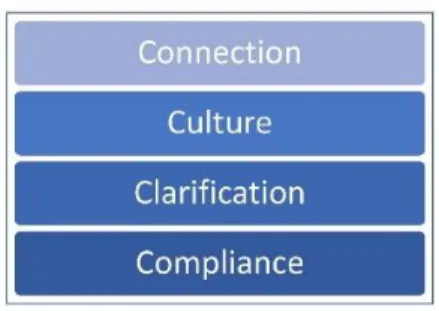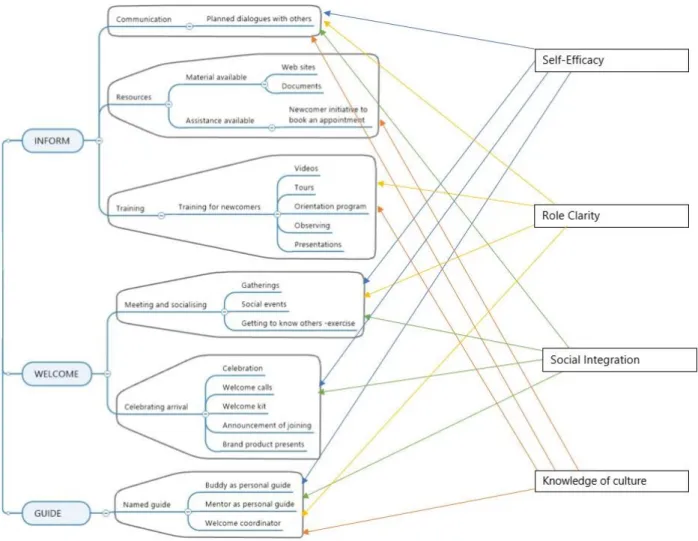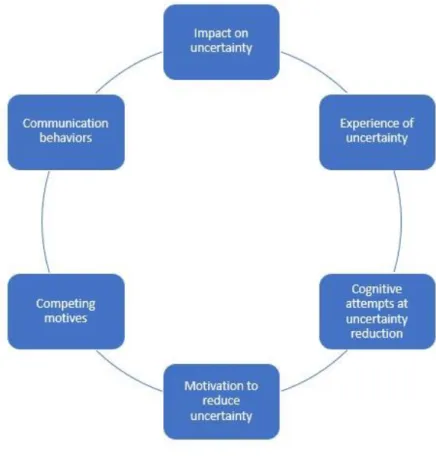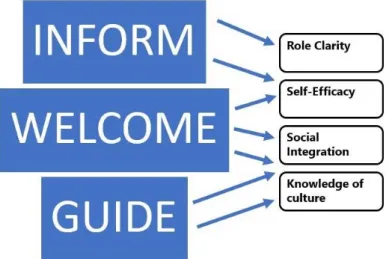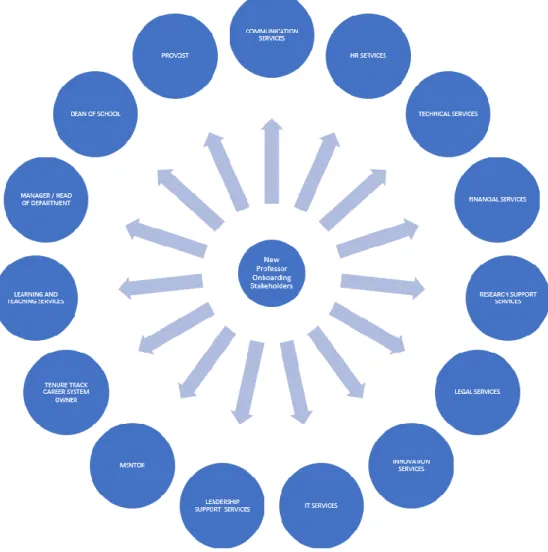The development work began with the mapping of the current situation of the involvement of professors in the organization of the case. The development project for a new faculty engagement framework was developed using the double diamond model of service design.
Research question
The onboarding framework model will be implemented in the case university once the development work in this dissertation is completed, with the expectation that it will acculturate and network new professors faster than before. One of the goals in developing the new onboarding framework was to identify the different stakeholders and their role in onboarding new professors.
Higher education and professors
This thesis does not concentrate on the very special needs that professors who come from abroad have, such as integration issues with their family and spouse. Staff includes other academic employees such as postdoctoral researchers, doctoral students and research assistants as well as support staff.
Case organization
Comprised of several research areas, the university houses a foundation for interdisciplinary research that accelerates new scientific innovations and solutions to the world's wicked problems. The theories used in this initial creation process for the professor's onboarding are quite fundamental and almost classic.
Organizational socialization and onboarding
According to Rantala (2018), orientation is information delivery to the newcomers that originates from the needs of the organization. According to the articles in the Oxford Handbook on Organizational Socialization (2012), socialization seems to be the most important factor when a new employee has to adapt to a new workplace and new tasks.
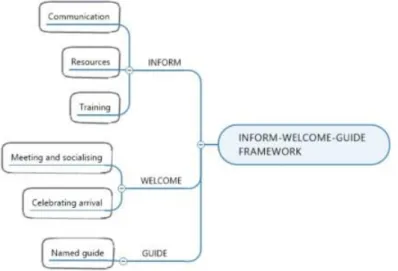
Uncertainty and uncertainty reduction theory
Three ways to reduce uncertainty is a passive approach which means observing the new person and learning to understand the individual from that. Competing motives to reduce uncertainty involve, for example, situations where one is afraid to ask for help from others.
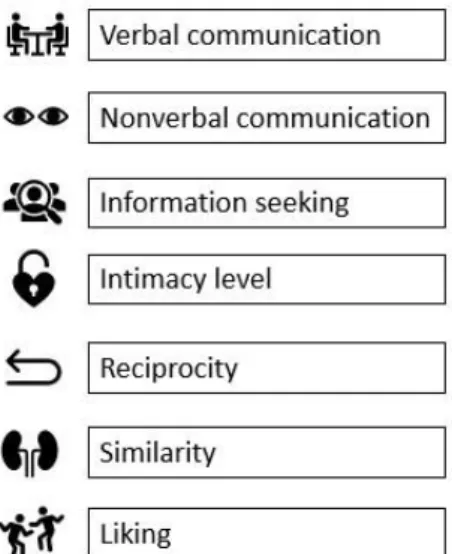
Summary of theoretical background
The concrete result of this thesis is a new framework for professor onboarding that fits the needs of the case university. The new professor onboarding model will be implemented in the case university when the steps described in this thesis are completed.
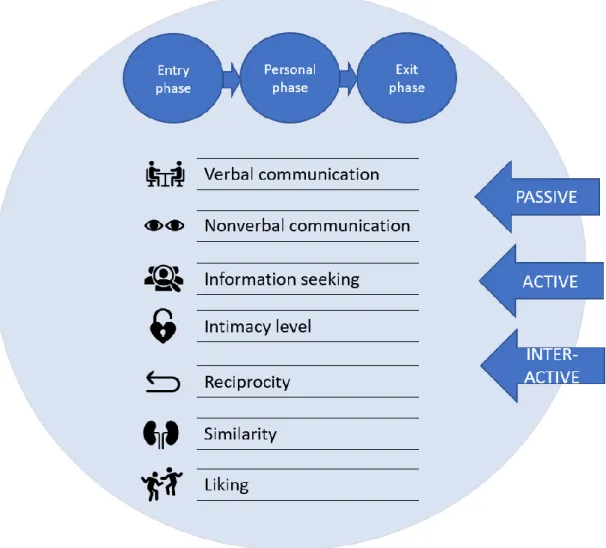
Theory of service design
According to their feedback, a finalization of the framework will be made along with a plan for the ongoing future development of the professor onboarding framework model. Figure 9 shows the phases of the service design double diamond framework in a visual way. Service design methods should be chosen depending on the topic and goals of the projects at hand.
Questioning the service journey with different scenarios can help design different aspects of the journey. The customer journey map brings customer insight into a timeline of the service process from the customer's experience (Curedale 2013).
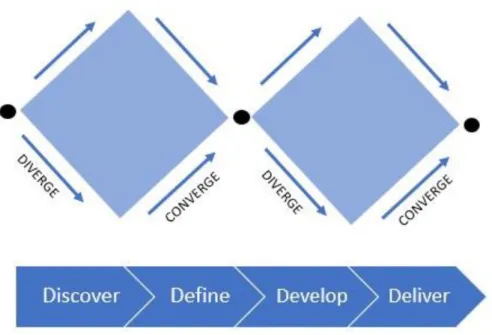
Qualitative research
Thematic analysis of the data
Figure 10 shows chronologically when and what data was collected during the service design project on the development of the professor onboarding framework. In the development phase, all this previous information along with best practices from research articles was analyzed and divided into different categories based on their topic and their chronological order in the professor onboarding. In the final phase, the delivery phase, feedback was collected from service units involved in the onboarding of the professor, but also from the university professor.
After feedback discussion with stakeholders/representatives of the professor onboarding, new areas were found that should also be included in the professor onboarding. There were fewer topics for those later stages, but still there were some that made them relevant to be included in the framework.
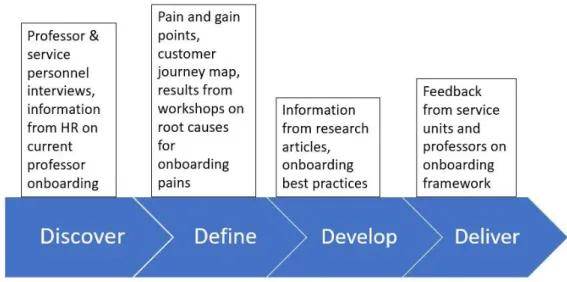
Stakeholder map
Interviews
The interview questions for the service staff dealt with topics such as service unit's strategy for professor onboarding, what they wanted to achieve with it, current.
Current onboarding process at the university
The pain points of the new professor onboarding journey were presented in the professor interview quotes. In the onboarding interview, in the first or second week, it is made clear to the new professor that he can contact the technical service for anything.”. A problem arose during the onboarding of the professor if the service unit was not aware of the arrival of the new professor.
HR must inform all service units and stakeholders about the new professor as soon as possible. The new professor meets with the service units to get a contact there, get a face for the service, and get an introduction and orientation to the service.

Customer journey map
After receiving the message about the prospective professor, each service organizes an orientation interview for a new professor. An important learning point for the new professor is to realize that it is better to first talk to the waiting staff about your own plans and only then take action. The channels for onboarding the new professor are usually phone calls, emails, web pages, electronic documents, paper documents, formal meetings (online and face-to-face), informal lunch meetings and coffee meetings, formal face-to-face trainings, independent learning online and offline , supportive relationship with a mentor or a colleague.
However, the behind-the-scenes process was not very clear for any of the new professor's stakeholders to onboard and resolve that issue was one of the solutions this thesis development work has. The client is the most important player in service design project, but the background must be in order and responsibilities must be clear in order to fulfill the optimal experience for the new professor.
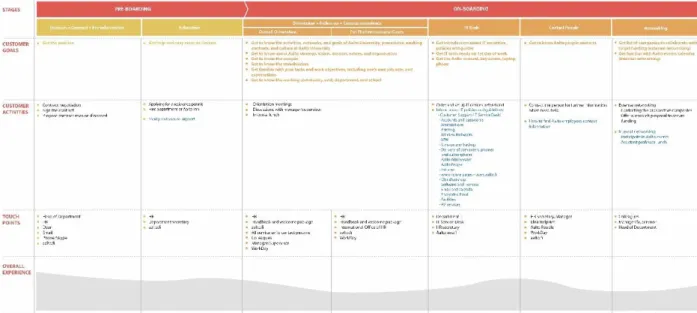
Workshops
This would exclude many of the new professors from the orientation program if it were held twice a year at the beginning of each academic semester. With most of the stakeholders, a meeting will be arranged or at least some self-study orientation will be provided for the new professor. Based on the new professor's background and experience, the components of the onboarding plan will be refined.
This states that in this thesis and the new professor onboarding framework, networking with more experienced employees should be a part. In order to continuously develop the new onboarding model for professors, two more elements have been implemented.
Stages and contents of the onboarding framework
Recruitment stage
In the new professor employment framework, during the recruitment period all candidates receive job information. First, in the job announcement and later in interviews, but also whenever they randomly ask questions from the recruiter. In the new phase of recruitment in the framework of the introduction of the professor, the orientation topics included here are orientation to the career system and, if it is suitable for the new professor, information about the technical facilities that the professor may be interested in related to the topics of his research.
Orientation for this starts as early as the recruitment phase and continues for a year or as long as it takes for the person to feel fully adjusted. Learning about the tenure track career system also begins at the hiring stage as the career system is discussed in the interviews.
Preboarding stage
The time from accepting a new job to the actual first day at work is very fruitful for. All of this material can preferably be sent to the new professor as a link to the online content. On top of all this electronic material, there's also the option of sending university-branded products to the new professor's home before arrival as a welcome surprise.
The plan itself is built during the pre-boarding period, but is handed over to the new professor on the first day at work. Part of the plan is a framework visualization similar to Figure 9 that is distributed to the new professor to understand the scope of the onboarding program.
Onboarding stage
Usually the new professor meets the HR representative on the first day to discuss practical matters. The manager or a colleague gives a tour of the facilities and introduces the new professor to everyone who comes by. The new professor is led to his own workspace and the tools must be ready on the first day.
Each new professor will be assigned an Onboarding Buddy for the first six (6) months to support early integration. On top of all the existing 3-4 month orientations, a few more things pop up, making it the busiest time for new professor onboarding.
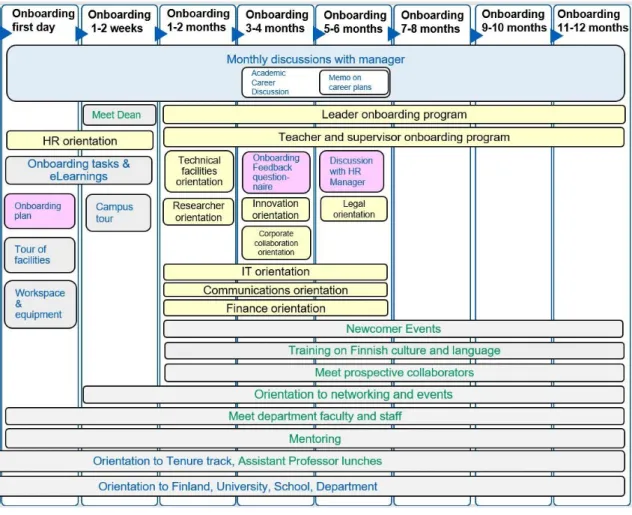
Testing the new professor onboarding framework
Cross-checking with theory
In the welcome category of the Inform-Welcome-Guide framework, the onboarding framework for professors provides encounters and socializing, such as participation in professor-focused events, participation in events for newcomers, informal coffees and lunches with other staff, meetings with other professors , teachers and senior teachers in the department and interviews with service contacts. At the level of compliance, the new employee must be taught basic legal and policy-related rules and regulations. This is covered in the professor onboarding framework through meetings with service representatives, meetings with other faculty, and meetings with the head of.
In the beginning of the new professor's onboarding, common topics are discussed instead of personal ones. In the long run, spend your time with those who are like and like you.
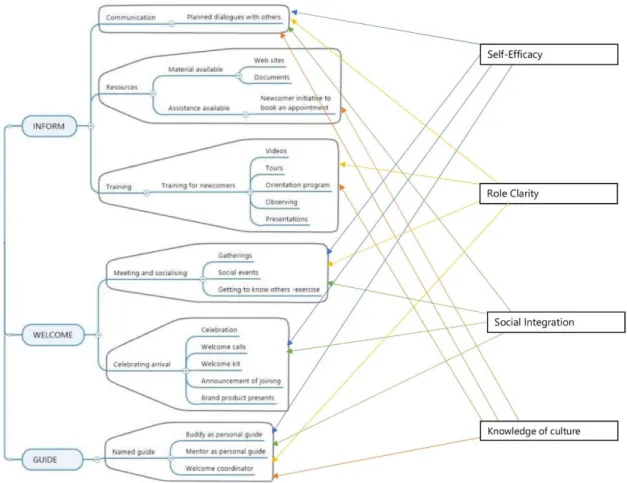
Feedback from professors
The professors interviewed felt that, looking back at their own onboarding period, much of the content of this new professor onboarding framework already existed at the thematic level. The new virtual experience of the university campus was an element that was already considered very informative for new professors in the recruitment phase. Many professors had specific wishes for the new professor onboarding framework, often based on their own experience and challenges.
Having a concrete space and online presence in the new organization would help the new professor feel very welcome and part of the organization. Other suggestions for improvement from the interviews with the professor will be forwarded by the dissertation author to the stakeholders of the professor being introduced at the case university.
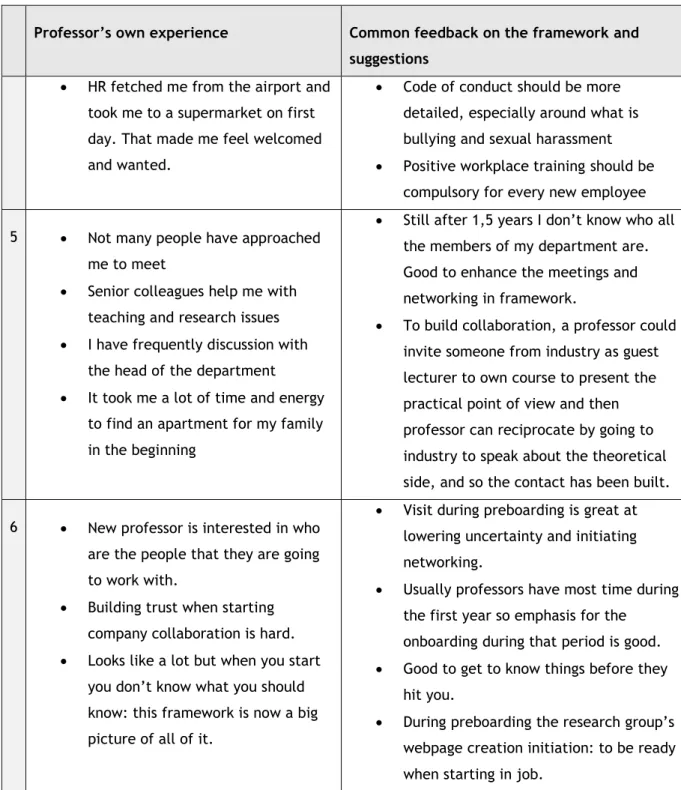
Evaluation and transferability
The overarching research question for this development assignment was "What does a successful induction framework include from both the new professor's perspective and the organization's perspective?" The creation of the new framework has involved both stakeholders and young professors in bringing these aspects to it. The names of the interviewees were not revealed to other members of the organization except the author and the assistant. The fact that the author of the thesis has worked for several years in organizing the case may blind her to some of the flaws in the professor's holding.
The author was involved in the interviews with the service personnel, in preparing the questionnaire for professors, in the workshops presenting the results of the current situation of professor onboarding and in many meetings with stakeholders of professor onboarding. The involvement of the stakeholders early in the project made them responsible for the onboarding process.
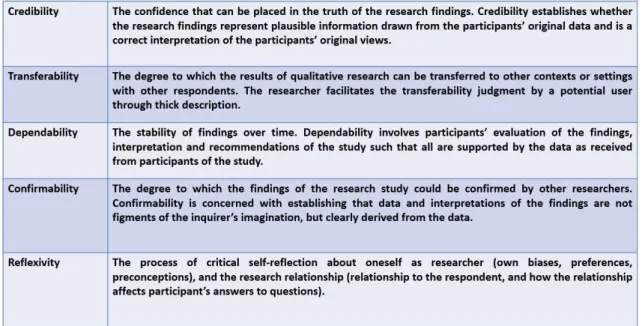
Future developments of the onboarding framework
This is Service Design Doing: Applying Service Design Thinking in the Real World: A Handbook of Practice. Turning off the Firehose and Fostering Community for the New Professor: Five Institutional Perspectives on New Faculty Orientation. Specific onboarding practices for the socialization of new employees, International Journal of Selection and Assessment.
Pathways to the Professoriate: The role of the self, others and the environment in shaping academic career aspirations.
